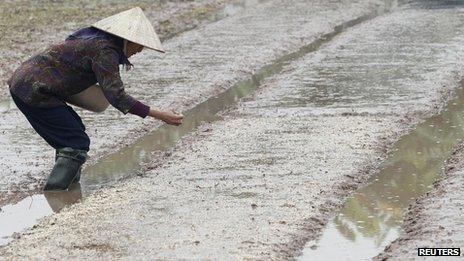Salt-tolerant rice 'could aid Japan's tsunami farmers'
- Published

Scientists have found rice mutants that could be grown on land covered in salt
UK scientists have claimed a breakthrough in research on rice that could help farmers devastated by last year's tsunami in Japan.
Researchers in Norwich said a method of identifying and isolating crop traits has been developed that means new varieties could be created in a year.
A Sainsbury Laboratory scientist said Japanese farmers could now grow a salt-resistant crop within two years.
It previously took up to 10 years to develop new crop strains, he said.
Much of the agricultural land to the north east of Japan was drenched in sea salt from the tsunami, which has since made it hard for rice to grow.
As part of the research between the UK and Japan, a spokeswoman from the Sainsbury Laboratory said seven salt-tolerant mutants have now been identified in a particular type of rice, meaning breeders could be creating usable varieties for Japanese farmers in the next few years.
"This is a huge leap forward," said Dr Brande Wulff from the Sainsbury Laboratory at Norwich Research Park.
Crop traits
"Advances in technology allow us to sequence plant genomes and identify gene variants that give rise to desirable traits.
"Our colleagues in Japan have already identified mutants that are more salt-resistant.
"Now it's just a matter for them to back-cross those mutants to the parental variety and clean up the background - get rid of the bad mutations and keep the good one - and then bulk up the seed provided to the farmers," he said.
Crop traits such as drought and salt tolerance, plant height and yield are often controlled by many genes, with each having a subtle effect, the laboratory spokesman said.
It is therefore difficult to identify the complete genetic basis for a particular characteristic, he added.
But in the new research method, called MutMap, the laboratory said scientists can now identify the characteristics by working with an "elite" rice and creating mutants that harbour different traits.
'Genomics revolution'
Once a mutant is identified with the desired trait, for example salt tolerance, this can then be crossed with the original rice and grown in a field.
The difference between the offspring of this cross and the elite rice can then be identified.
The changes detected are called single-nucleotide polymorphisms (SNPS) and insertion-deletions (indels), which are tiny genetic improvements that can be observed using genome sequencing.
"Until now, plant breeding has not been able to take advantage of the genomics revolution," said Professor Ryohei Terauchi, from Japan's Iwate Biotechnology Research Centre.
"MutMap overcomes one of the greatest limitations, which has been the time it takes to identify genetic markers for desirable traits."
Results from the study have been published in Nature Biotechnology, external.
- Published17 November 2011
- Published8 November 2011
- Published6 October 2011
- Published5 June 2011
- Published3 May 2011
- Published9 February 2011